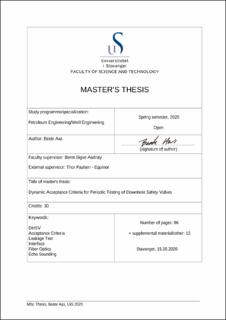| dc.contributor.advisor | Aadnøy, Bernt Sigve | |
| dc.contributor.advisor | Paulsen, Thor | |
| dc.contributor.author | Aas, Beate | |
| dc.date.accessioned | 2020-10-19T13:11:56Z | |
| dc.date.available | 2020-10-19T13:11:56Z | |
| dc.date.issued | 2020-06-15 | |
| dc.identifier.uri | https://hdl.handle.net/11250/2683691 | |
| dc.description | Master's thesis in Petroleum engineering | en_US |
| dc.description.abstract | Downhole Safety Valves (DHSVs) are periodically leak tested as part of the preventative maintenance program on an oil and gas producing facility. The last couple of years, the oil and gas industry on the Norwegian Continental Shelf (NCS) has experienced too high failure fractions on the periodic leak testing of DHSVs. From this result it is believed that refining the way the acceptance criteria is calculated today might reduce this failure fraction. The thesis work therefore investigates the possibility of implementing a more accurate, more representative and more time-efficient method to calculate the acceptance criteria compared to the method used today. This is done by defining a Dynamic Acceptance Criteria (DAC) which includes the effect of gas and liquid variations in the testing volume.
The research methods used to investigate the thesis problems are divided into three main parts. The first part is the derivation of two equations that can be used to calculate DAC. One for testing volumes with high gas fractions, and another for testing volumes with high liquid fractions. For the second part, a code is developed to find the depth of the interface between gas and liquid in the well based on given input. Results from the code are further used to calculate the different gas or liquid fractions. The third part investigates the use of different measurement methods. The methods are evaluated based on their potential of locating the gas and liquid interface in the well. These methods are Fiber Optics and Echo Sounding.
A small study is performed to investigate the impact of using DAC. The method of using DAC proved to have a great potential for reducing the failure fraction of DHSV leakage tests. There are, however, a lot of uncertainties regarding the method. Further research combined with a more representative study is recommended.
From the research methods, the use of the DAC is concluded to be more representative for the periodic leak tests of DHSVs. This is compared to the acceptance criteria used to evaluate DHSV leakage tests today. Further, it is concluded that using DAC will result in a more time-effective operation for the testing procedure of the DHSV. Finally, it is unclear whether the DAC is more accurate or not compared to the acceptance criteria used today. The accuracy of DAC must therefore be further researched before DAC can be implemented to evaluate real periodic DHSV leakage tests. | en_US |
| dc.language.iso | eng | en_US |
| dc.relation.ispartofseries | Masteroppgave/UIS-TN-IEP/2020; | |
| dc.subject | petroleumsteknologi | en_US |
| dc.subject | petroleum engineering | en_US |
| dc.subject | boreteknologi | en_US |
| dc.title | Dynamic Acceptance Criteria for Periodic Testing of Downhole Safety Valves | en_US |
| dc.type | Master thesis | en_US |
| dc.subject.nsi | VDP::Teknologi: 500::Berg‑ og petroleumsfag: 510::Petroleumsteknologi: 512 | en_US |
